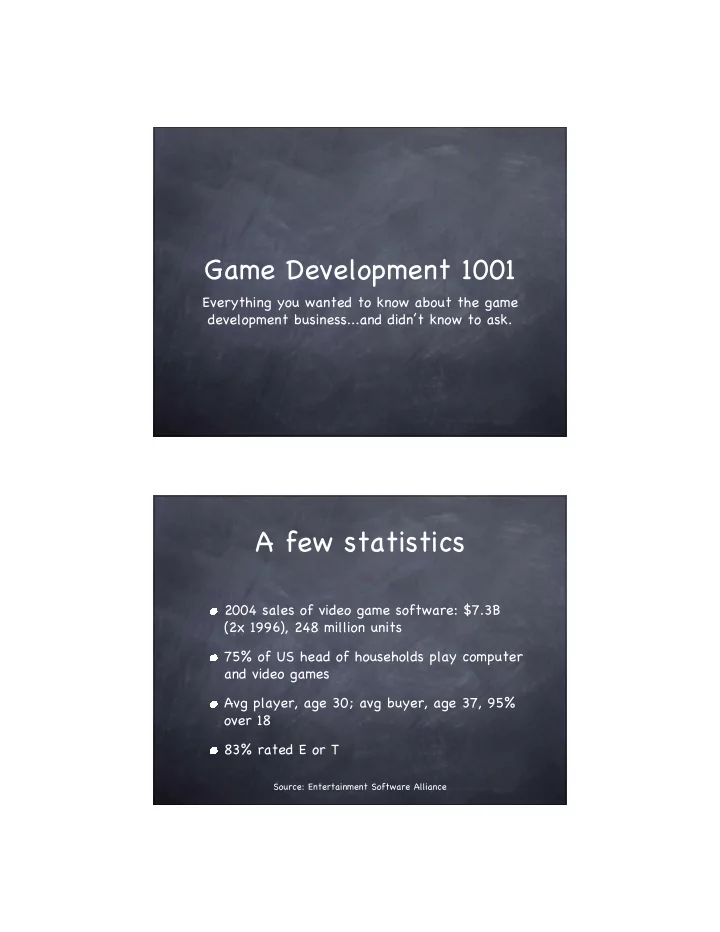

Game Development 1001 Everything you wanted to know about the game development business...and didn’t know to ask. A few statistics 2004 sales of video game software: $7.3B (2x 1996), 248 million units 75% of US head of households play computer and video games Avg player, age 30; avg buyer, age 37, 95% over 18 83% rated E or T Source: Entertainment Software Alliance 1
More Stats 43% of all game players are women Women >18 = 28% of game players Boys <18 = 21% of game players 19% of people >50 play video games 42% play online, 34% on phone or PDA Growth from 2003 to 2004 Console Software: 8% Portable game software: 13% Portable game hardware: 9% (source: NPD Funworld) 2
Hit-Driven Entertainment Games are emotional, escapist, fantasy- ful fi lling, stimulating entertainment Causes of success or failure are often intangible (but quality matters a lot) Consumers are smart Hits come from individuals with skill, instinct, creativity, and experience, not from marketing Costs Powers of 10 $50K -- cell phone game (JAMDAT bowling) $500K -- indie title (MindRover), nice casual game (Peggles) $5M -- “A” title (Titan Quest) $50M -- “AAA” title (WoW) 3
WoW $50 Million to make 6 Million players @ average of about $12 / month for 2-3 months = $200 million a year Less the cost of running those servers How the game industry works: 4
Roles Developer Toolmaker Service Provider Publisher Distributor Retailer Developers Design and implement games Responsible for the content Analogous to book authors Sometimes fi rst party (part of publisher) Or third party (independent business) More later 5
Publishers “To fi nd the publisher in any deal, look for the one who’s got negative cash- fl ow during development” -- Dan Scherlis Handle manufacturing, marketing, PR, distribution, support Typically specialized in certain markets Assume the risk, reap the pro fi ts Might also handle QA, Licensing, project management Relationship to developers Star devs can bully publishers, because publishers desperate for good content Most devs are bullied by publishers, because devs desperate for money Publishing swings from big to small and back depending on the market Most also have in-house developers 6
Distributors Move software from publisher to retailer Modeled on book distribution Pubs like them because they manage relationship with many small stores Stores like them because they manage relationship with many pubs Compete on price, speed, availability Very low margins (3%) -- dying breed Retailers Sell software to end users But really sell shelf space to publishers Compete on price, volume of product Originally, computer stores, then game stores (EB, GameStop), then mass market (WalMart) Markup of 30-50% ... but net margins about 6% ... endangered species 7
Service Providers Sound, Music, Voiceover Artists (2D, 3D, concept) QA PR Advertising Middleware Provide the tools used by developers Small: Game Maker, Torque Medium: Havok, Rad Game Tools Large: Doom, Unreal Engine Few customers, large upfront cost, hard to break in...limited growth but pro fi table 8
Industry Leaders Hardware vendors Sony, Nintendo, Microsoft, Intel Software Publishers EA, Activision, Sony, MS, Infogrames, Ubisoft... Developers EA, Sony, MS (Bungie), Blizzard, Lucas Arts, id, Namco, Square, Valve, Raven, Relic, Red Storm... 9
Traditional Game Development Developer creates concept Developer builds demo Developer meets with publishers Publisher agrees to fund it (advance against royalty) Project gets developed Publisher boxes it, ships it, markets it Publisher collects money Developer MIGHT make more money...if advance is earned out. Traditional Model: Cross between books and Hollywood Less than 10% of published titles break even Sequels very popular Development costs rising Self-publishing is nearly suicidal Retail and distribution control access to customers 10
Indie Game Development Developer creates concept Developer turns concept into a game Developer fi nds nontraditional publisher to sell game Sometimes self-publishes Publisher responsible for web storefront Developer gets 30-40% of each sale How the game industry REALLY works: 11
Exercise 2 minutes to write a one-sentence game description of a game you want to make Form up into pairs or teams based on yesterday’s pairings 2 minutes to decide on ONE of your ideas Allocate Points You have 14 points Split them between: B: Business development E: Engineering M: Marketing and sales D: Design 12
Roll for: How many publishers you talk to (B) Whether your game makes it through development (E) How effective is the marketing and market timing (M) How much consumers like it (D) How many are left? Yes, luck is a factor You can control it some with skill and money But there’s never enough of either to make it a sure thing 13
Recommend
More recommend